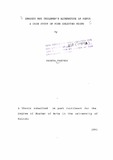| dc.description.abstract | This thesis examines the role of imagery in conte¬mporary children's literature in Kenya in relation to the impressionability of the nine to twelve year old reader. It starts off with outlining the place and role of children's oral and written literature in Kenya. The discussion emphasizes the aesthetic and cognitive function of literature. It further discusses the nature, the types, the functions and the significance of imagery in children's literature, by giving operational definitions of the terms, •• imagery" and •• image" , whose significance is derived either from the linguistic, or from the extra-linguistic contexts. In addition, the thesis chapter discusses the nature and functions of various figures of speech sUch as simile, metaphor, hyperbole and personification.
Further, it also esta~lishes that by comparing abstract qualities to physical entities, it is easier for young readers to cognize reality. This is done by using examples from children's literary texts to illustrate imagery.
Finally, this thesis makes a textual analysis of four selected texts that are representative of the contemporary written prose for children in Kenya.
An analysis of the imagery in Ngugi Wa Thiongo's, Njamba Nene and the Flying Bus,(1986) Saleem Rana' s, Courage to Dream,(1988) Juma Bustani' s, Adventure in Mombasa (1988)and Elijah Kariuki's, A Car Named Safari,(1981) is intended to explore the hypothesis that imagery in children's literature in Kenya is not just a rhetorical ornament, but is also a literary agent which helps in shaping the value system and outlook of the young reader. The concepts developed in the previous chapter are employed to make a concrete analysis of the four selected texts. The response of the children to the images in the text will be used to support and clarify the hypothesis.
The analysis of the four children's stories attempts to demonstrate that children's literature has a fecundity of images that conveys the attitudes, the implicit... value judgements, the vision and the world view of the writer.
An attempt is made to show the aesthetic and highlight the cognitive functions and significance of imagery in children's literature. | en |

